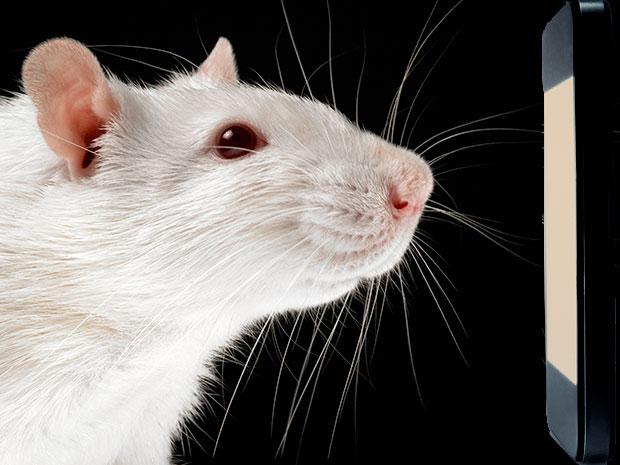
Cellphone Radiation Linked to Cancer in Major Rat Study

Results of the largest, most expensive animal study on the link between cellphones and cancer are in. And the link is positive—weak, but positive.
The much-anticipated two-year study led by the National Toxicology Program (NTP) has found low incidences of brain and heart tumors in male rats that were exposed to the radio frequency radiation commonly emitted by cellphones.
Exposed rats had higher rates of two malignant cancers: glioma of the brain and schwannoma of the nerves in the heart. But none of the unexposed control rats developed them. And these brain and heart tumors are similar to the ones found in previous epidemiological studies of cellphone use, the NTP report states, so “these findings appear to support the International Agency for Research on Cancer (IARC) conclusions regarding the possible carcinogenic potential of” radiofrequency radiation.
In 2011, the IARC, which is part of the World Health Organization, convened an international panel of experts that concluded that exposure to RF radiation including that used by cellphones is “possibly carcinogenic to humans.” The panel analyzed available scientific papers and concluded that even though evidence was limited and incomplete, epidemiological studies had shown increased risks of 40–200 percent for gliomas and acoustic neuromas (benign tumors of the auditory nerve) among heavy and/or long term cellphone users.
With a price tag of US $25 million, the peer-reviewed NTP study released today is the largest animal study to date on the effects of cellphone radiation. The project suffered from complications and huge budget overruns and these results are years overdue. The NTP commissioned the Illinois Institute of Technology Research Institute in Chicago to perform the study back in 2005. There have been no updates until this report, which only gives partial data. Only findings from the brain and heart have been reported and studies on mice are still being evaluated. The NTP plans to release two more reports by 2017.
The reason NTP released the rat brain and heart data early? “Given the widespread global usage of mobile communications among users of all ages, even a very small increase in the incidence of disease resulting from exposure to RFR could have broad implications for public health,” according to the researchers. Statistics show that the number of mobile phone users will pass the 5 billion mark by 2019.
The NTP study was designed to mimic human exposure and look at effects on all parts of the body. Researchers conducted the experiments in an underground lab with specially designed radio-frequency chambers to house the rats. The animals were exposed to 900 megahertz radio waves modulated using Code Division Multiple Access (CDMA) and Global System for Mobile Communication (GSM) modulation. These are cellphone frequencies and modulations currently used in the United States.
The animals’ bodies were exposed in utero and over their two-year lifetimes to CDMA or GSM-modulation radiation at different dose levels: 0 (control group), 1.5, 3 and 6 watts per kilogram of tissue mass. That’s seven test groups for each sex with 90 animals in each group. The animals were irradiated over a period of about 18 hours per day, with exposure for 10 minutes followed by 10 minutes without radiation, for a total daily exposure time of nine hours.
Gliomas appeared in around 2–3 percent of male rats in each group while schwannomas appeared in 1–6 percent. The incidence of schwannomas was significantly higher in the male animals that were exposed to the 6 W/kg levels. There were no similar results in females. And, for some unexplained reason, the researchers found that the unexposed rats died younger than exposed animals.
So what does this all mean? The results are fairly weak and confounding but provide the first positive evidence in animals and will grab the attention of health agencies, says Kenneth R. Foster, a bioengineering professor at the University of Pennsylvania.
First, animal studies are very hard to translate to humans, he says. The exposure levels used in the study are much higher than what’s typically allowed for humans. The exposure limit for occupational users is 0.4 W/kg and for non-occupational users is 0.8 W/kg. “The results are only in male rats, the incidence numbers were very small, and there’s no clear dose response,” he says. Also, he asks, “did the control rats not live long enough to naturally develop these tumors?”
Nonetheless, an NTP study is the gold standard for animal cancer assays. And health agencies look at both epidemiological and animal studies to make recommendations. “Past epidemiological studies are weak but suggestive,” says Foster, “and here you have the first borderline positive result in animals. So now you have a stronger case.”
In response to WHO’s 2011 “possible carcinogen” classification, Belgium adopted regulations to promote cellphone radiation safety and banned the sale of cellphones to children, Foster points out. The French Health Agency recommended that children and vulnerable groups should take measures to reduce their cellphone RF exposure. The U.S. Federal Communications Commission, meanwhile, states that no evidence points to a direct link between wireless device use and cancer or other illnesses. And the Food and Drug Administration advises that if there is a risk, it is very small.
With the NTP study results, Foster expects more governments to put out cautionary guidelines and radiation labeling for cellphones. He says he wouldn’t be surprised if California adds RF radiation to its Proposition 65 list of carcinogenic chemicals, and if the IARC ups its classification rating from 2B: possibly carcinogenic to humans to 2A: probably carcinogenic to humans. “And they wouldn’t be out of line in doing that,” he says. “This is going to change the rhetoric in the field. People can point to much more hard evidence that [cellphone RF exposure] really is a problem.”
Customer support service by UserEcho
